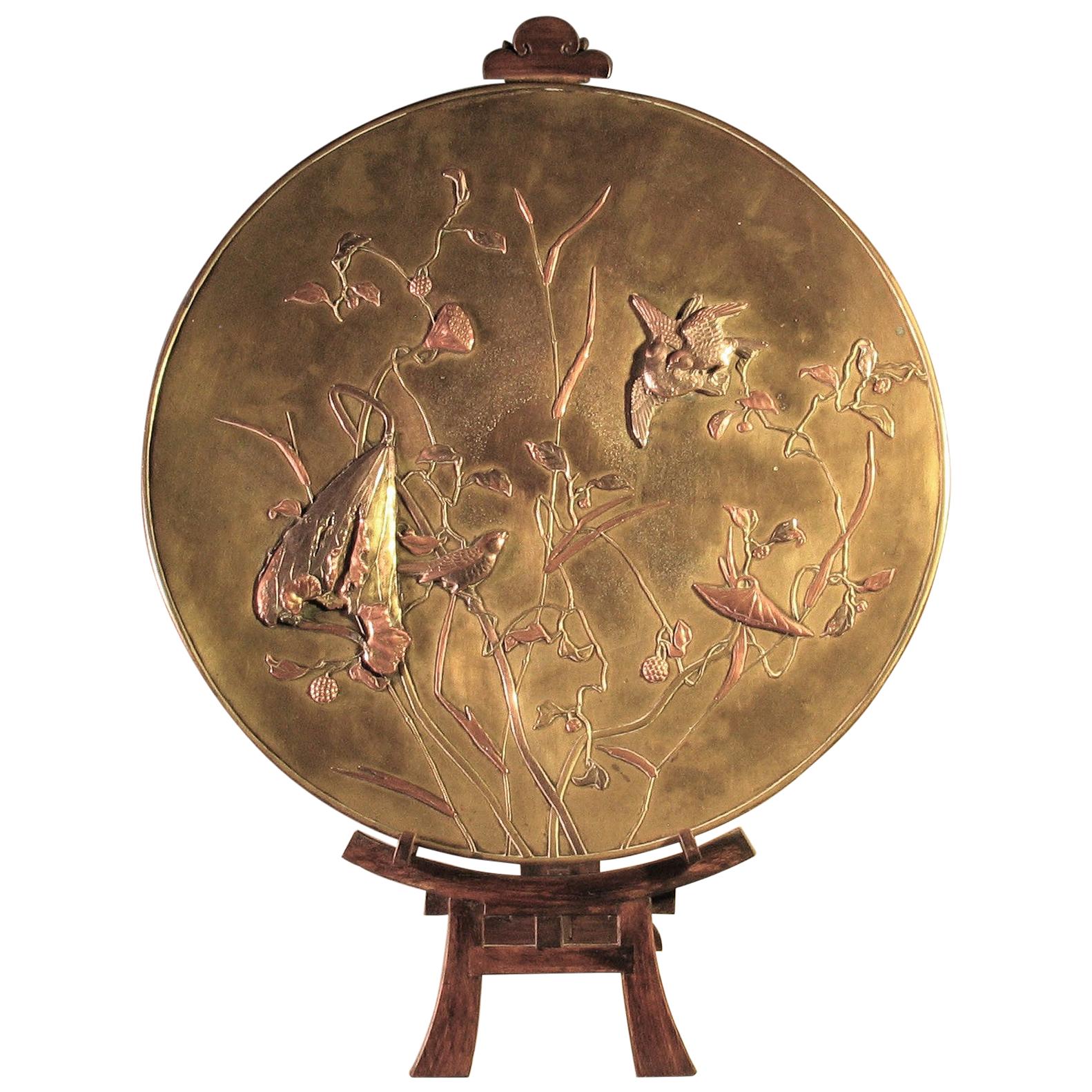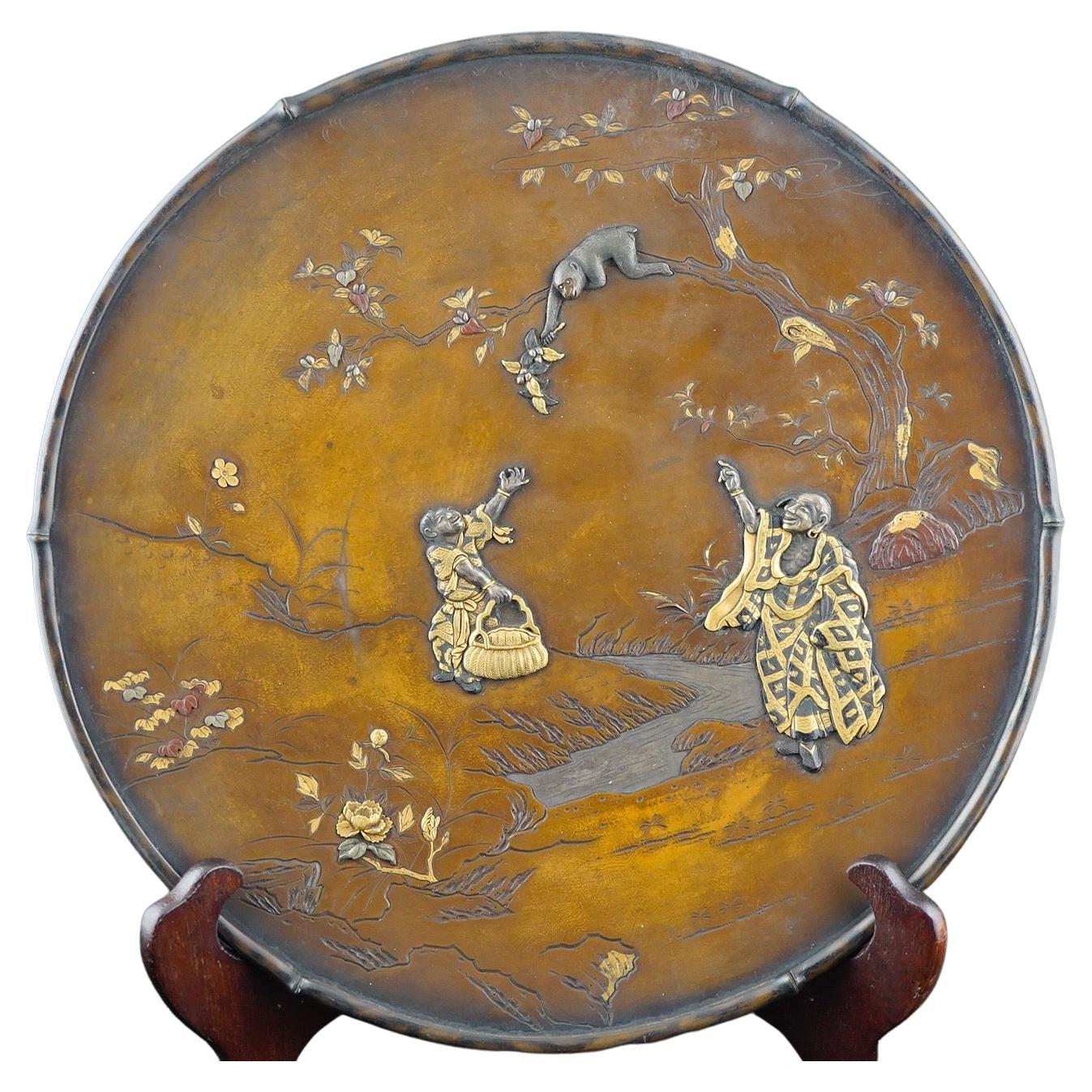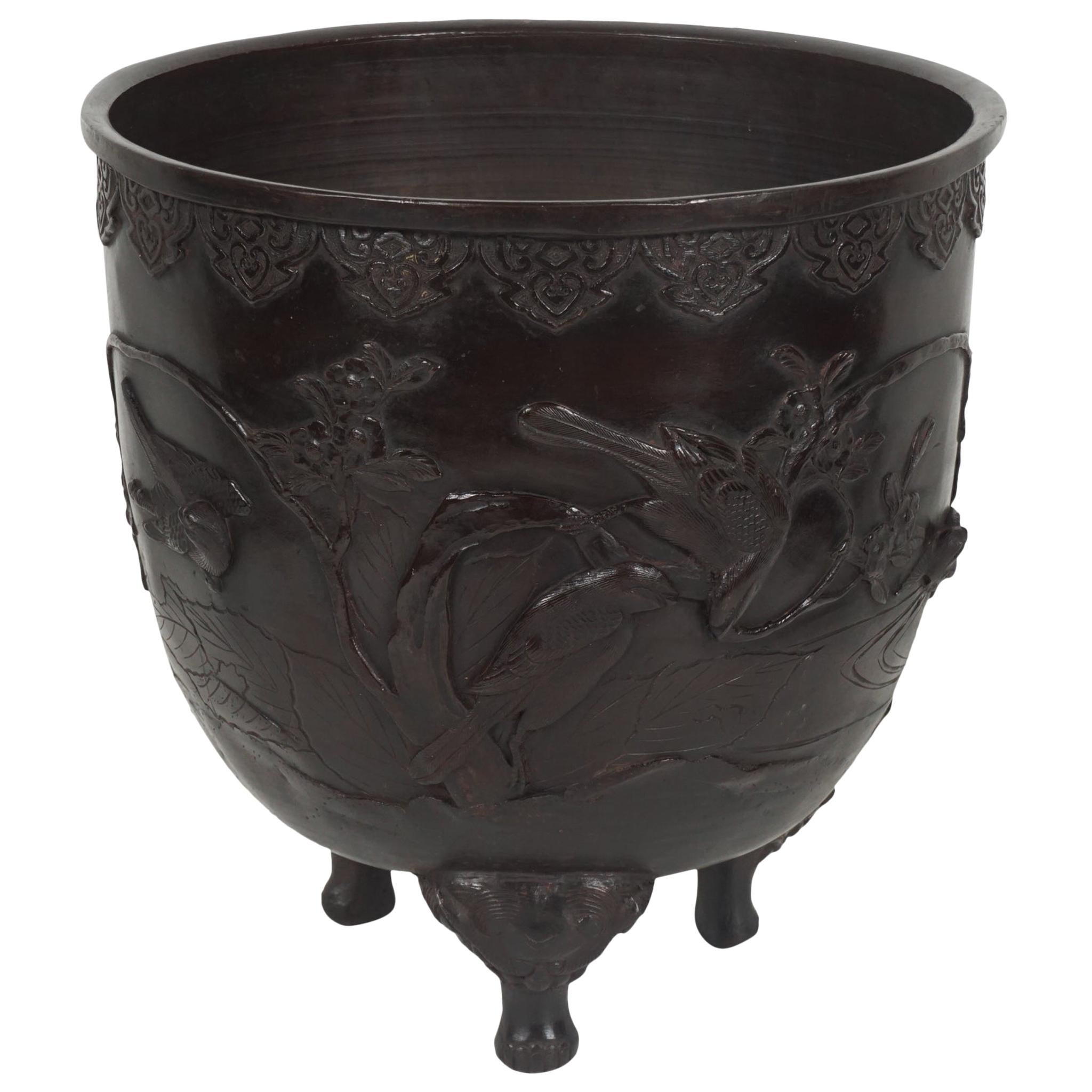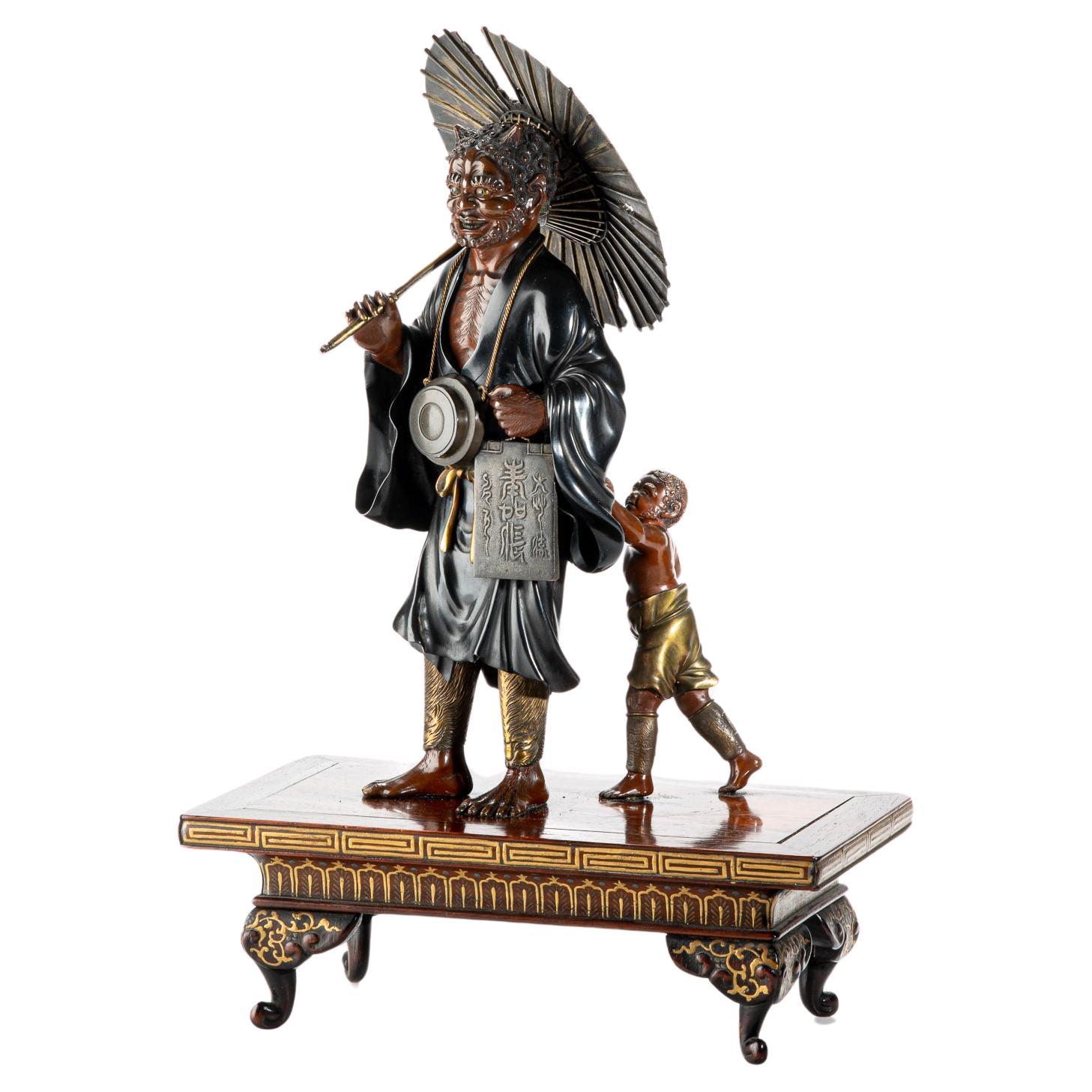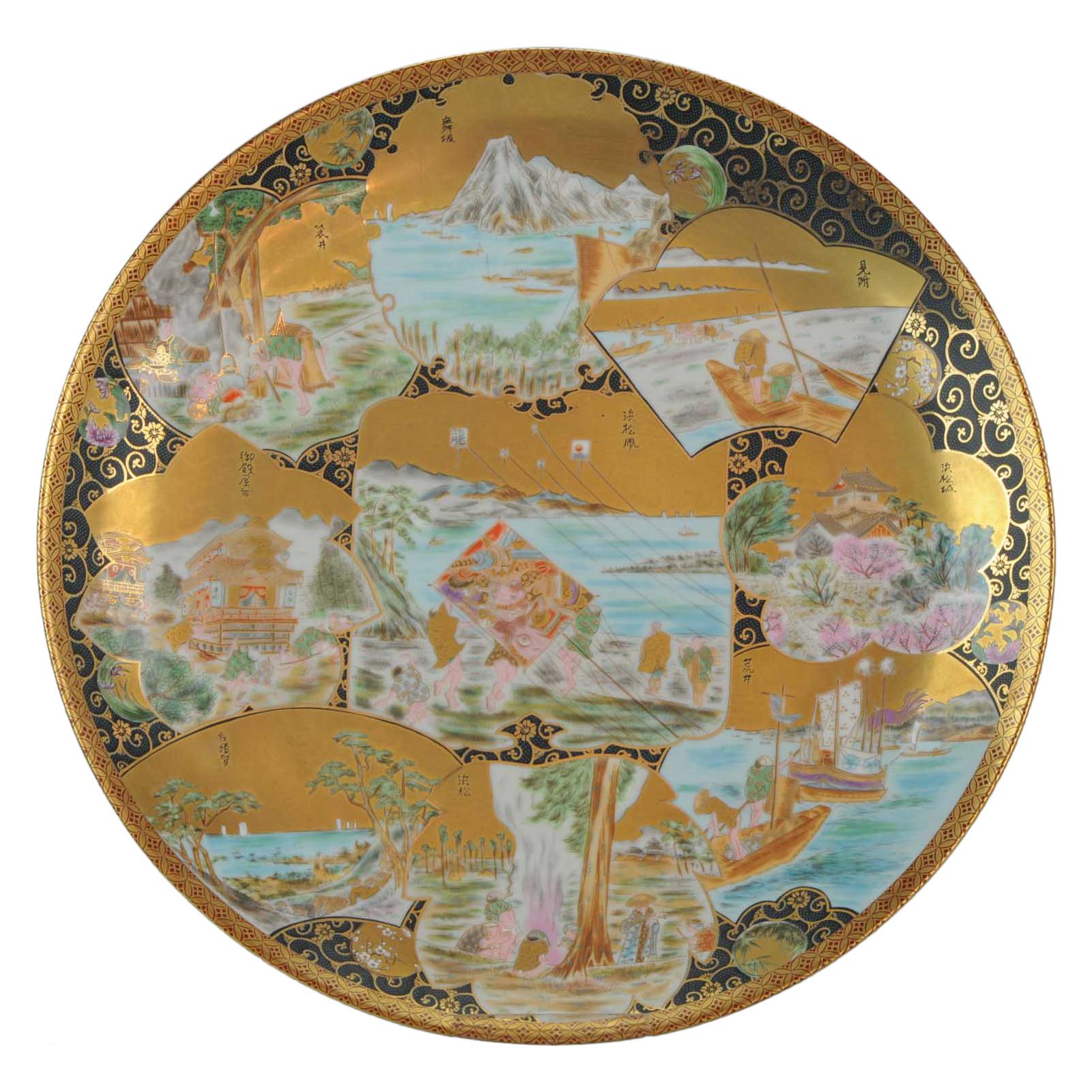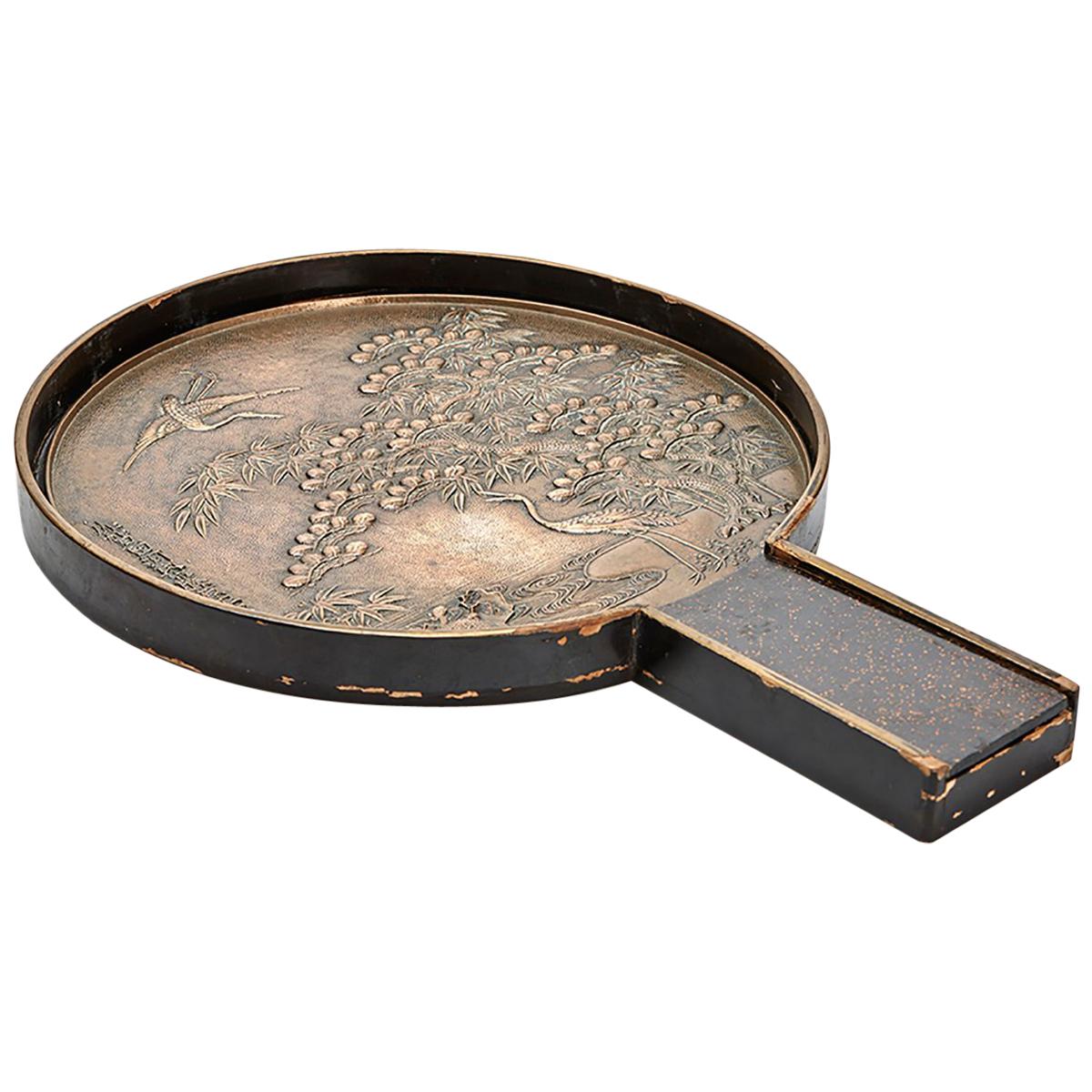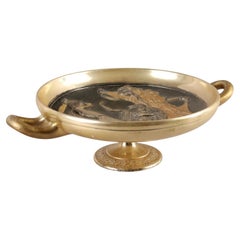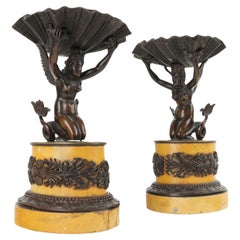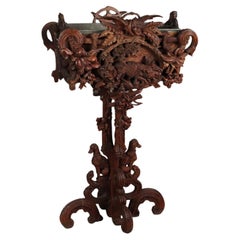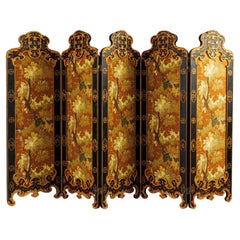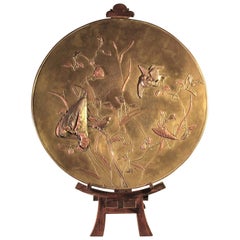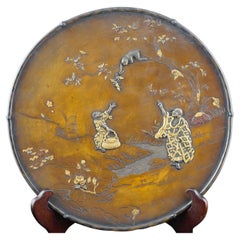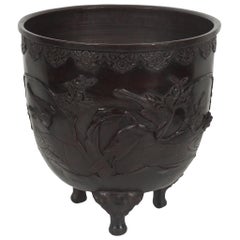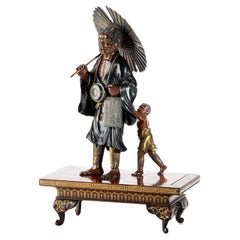Items Similar to Bronze Plate Japan Meiji Era 1868-1912
Want more images or videos?
Request additional images or videos from the seller
1 of 11
Bronze Plate Japan Meiji Era 1868-1912
$1,376.97
$1,721.2120% Off
£1,001.73
£1,252.1620% Off
€1,144
€1,43020% Off
CA$1,879.17
CA$2,348.9620% Off
A$2,092.63
A$2,615.7820% Off
CHF 1,089.10
CHF 1,361.3720% Off
MX$25,801.83
MX$32,252.2920% Off
NOK 13,870.47
NOK 17,338.0920% Off
SEK 13,036.90
SEK 16,296.1320% Off
DKK 8,706.37
DKK 10,882.9720% Off
Shipping
Retrieving quote...The 1stDibs Promise:
Authenticity Guarantee,
Money-Back Guarantee,
24-Hour Cancellation
About the Item
Bronze plate decorated with scene of lohans "enlightened disciples of Buddha" engaged in various prayer tasks in a river landscape of lotuses and birds. The figures of monks rendered in bas-relief in gold and silver agemine, the landscape artfully chiseled. The edge of the flowered lozenge plate worked partly in acid on lost wax.
- Dimensions:Height: 1.97 in (5 cm)Diameter: 18.12 in (46 cm)
- Style:Meiji (Of the Period)
- Materials and Techniques:
- Place of Origin:
- Period:
- Date of Manufacture:1800s-1900s
- Condition:Wear consistent with age and use.
- Seller Location:Milano, IT
- Reference Number:1stDibs: LU1721240033402
About the Seller
4.9
Platinum Seller
Premium sellers with a 4.7+ rating and 24-hour response times
Established in 2015
1stDibs seller since 2015
424 sales on 1stDibs
Typical response time: 2 hours
- ShippingRetrieving quote...Shipping from: Milan, Italy
- Return Policy
Authenticity Guarantee
In the unlikely event there’s an issue with an item’s authenticity, contact us within 1 year for a full refund. DetailsMoney-Back Guarantee
If your item is not as described, is damaged in transit, or does not arrive, contact us within 7 days for a full refund. Details24-Hour Cancellation
You have a 24-hour grace period in which to reconsider your purchase, with no questions asked.Vetted Professional Sellers
Our world-class sellers must adhere to strict standards for service and quality, maintaining the integrity of our listings.Price-Match Guarantee
If you find that a seller listed the same item for a lower price elsewhere, we’ll match it.Trusted Global Delivery
Our best-in-class carrier network provides specialized shipping options worldwide, including custom delivery.More From This Seller
View AllSilver riser Manifattura Le Argenterie di Milano di Fiorentini Guido
By Non-Standard Furniture and Lighting
Located in Milano, IT
Gilt silver riser supported by a circular base engraved with plant motifs. The burnished cavetto finely worked by burin provides the background for a mythological scene with figures ...
Category
Vintage 1950s Italian Mid-Century Modern Serving Pieces
Materials
Silver
$2,725 Sale Price
20% Off
Pair of Bronze and Yellow Siena Marble Risers, Italy First Quarter 19thsec
By Non-Standard Furniture and Lighting
Located in Milano, IT
Pair of risers in burnished bronze and yellow Siena marble, Italy first quarter 19th century. Oval marble plinth base, embellished with shell and beaded friezes at the bottom and a p...
Category
Antique Early 19th Century Italian Other Serving Pieces
Materials
Marble, Bronze
$6,018 Sale Price / set
20% Off
Neo-Baroque Planter in Carved Wood Black Forest Switzerland Late 1800s
By Non-Standard Furniture and Lighting
Located in Milano, IT
Black Forest planter from the late 19th century. Made of richly carved walnut wood. The four feet, like the supporting shaft, are carved in the guise of twisted branches on which ivy...
Category
Antique Late 19th Century Swiss Baroque Revival Planters and Jardinieres
Materials
Nutwood
$9,773 Sale Price
20% Off
Paravento alla chinoiserie. Italia, secondo quarto XIX secolo
By Non-Standard Furniture and Lighting
Located in Milano, IT
Paravento a cinque pannelli snodabili; in pioppo interamente laccato in nero, è decorato con motivi dipinti alla chinoiseie: dragoni, scimmie, volatili, e riserve raffiguranti scene di vita cinese, di giocoleria e di combattimento. Presenta cornici fogliacee dorate a decorazione della cimasa e della parte inferiore. Rivisitazione del designer Pietro Russo con stoffa Dedar.
Già ampiamente diffuse alla fine del secolo percedente, le chinoiserie ebbero una vera e propria diffusione nell’Ottocento, apprezzate e richieste dalle principali corti europee. I richiami alla Cina e all’Oriente in genere erano in grado di richiamare un esotismo tanto qpperezzato a livello estetico quanto a livello culturale.
Il calligrafismo dei disegni a chinoiserie, l’eterongeneo bestiario (sia reale che fantastico) e le scene di vita, offrivano infatti infinite soluzioni decorative per piccoli oggetti e intere pareti, creando interessanti effetti sccenografici nell’allestimento delle grandi sale. Tra i principali propomotori delle chinoiserie vi fu re Giorgio IV che, con la costruzione del Royal Pavilion a Brighton come palazzo di piacere sul mare, decise di allestire alcuni dei locali proprio con questo stile. In particolare la Banqueting Room, la Long Gallery e la Music Room presentano arredi, lampadari, oggettistica quali porcellane, ma anche moquette e vetrate, di gusto orientaleggiante.
Le pareti della stanza dedicata alla musica, furono decorate con scene di vita cinese, in oro su fondo rosso, realizzate da Frederick Crace e Henry...
Category
Antique 19th Century Italian Other Screens and Room Dividers
Materials
Poplar
$18,776 Sale Price
20% Off
Middle Victorian Side Table England Third Quarter 19th Century
By Jennens and Bettridge
Located in Milano, IT
Tray table , England second half of the 19th century. Made of finely chiseled and gilded bronze with papier maché top. Four uprights in the form of a winged dragon with goat's foot, ...
Category
Antique Late 19th Century English Late Victorian Center Tables
Materials
Bronze
$6,547 Sale Price
20% Off
Tabletop lectern. Early 18th Century
By Non-Standard Furniture and Lighting
Located in Milano, IT
Table lectern resting on a circular base and supported by a central stem, into which the height-adjustment rod engages, with mechanical device for tilting the brass lectern with blue...
Category
Antique 18th Century Austrian Other Music Stands
Materials
Brass, Steel
$43,812 Sale Price
20% Off
You May Also Like
Large Japanese Patinated Bronze Mixed Metal Charger Meiji Period, circa 1880
Located in Ottawa, Ontario
A large Japanese patinated bronze
Mixed metal charger
Meiji period
Finely decorated in gold, silver, copper and bronze.
Naturalistically accurate...
Category
Antique Late 19th Century Japanese Meiji Metalwork
Materials
Gold, Silver, Copper, Bronze
Japanese Mixed Metal Finely Executed Decorative Plate of Monkey Picking Fruit
By Japanese Studio
Located in Sarasota, FL
Meiji Period Japanese mixed metal platter depicting monkey gathering fruit for finely dressed gentlemen. Fine detail and execution of inlay.
Category
Antique Early 19th Century Japanese Meiji Metalwork
Materials
Metal
Large Japanese Meiji Period Open Bronze Censor
Located in Hudson, NY
This cast bronze censor is from Japan and was made circa 1880. Raised up on three legs which issue from demons mouths the container is cast with reliefs ...
Category
Antique Late 19th Century Japanese Meiji Metalwork
Materials
Bronze
A Japanese bronze okimono Oni Nembutsu
Located in Milano, IT
A Japanese great and remarkable bronze okimono, on a wooden base, depicting an Oni, dressed as a priest, accompanied by a young oni.
The main Oni is portrayed standing and smiling, ...
Category
Antique Mid-19th Century Japanese Japonisme Metalwork
Materials
Bronze
Fantastic Japanese Kutani Charger Figures and Scenes of Daily Life
Located in Amsterdam, Noord Holland
Large and very detailed piece.
Condition
Overall condition perfect in wooden box. Size: 315 mm
Period
Meji Period: circa 1900
Category
Antique Early 1900s Japanese Meiji Ceramics
Materials
Porcelain
$1,011 Sale Price
20% Off
Antique Japanese Meiji Bronze Mirror 19th Century
Located in Bishop's Stortford, Hertfordshire
An exceptional and stunning Japanese bronze handled mirror within a fitted black lacquered case. The mirror is polished to one side with the other s...
Category
Antique 19th Century Japanese Meiji Metalwork
Materials
Bronze
More Ways To Browse
1868 Furniture
Meiji Figure
Japanese Bronze Figure
Meiji Bronze Buddha
Hayashi Chuzo
Jambhala Antique
Japanese Belt Buckle
Japanese Meiji Champleve And Bronze Urn
Japanese Tanto
Kashmiri Enamel
Mamluk Revival Brass Inlaid With Silver
Tibetan Ewer
Tibetan Kapala
Wootz Steel
Amita Damascene
Antique Handheld Lantern
Articulated Bronze Lobster
Chola Dynasty
